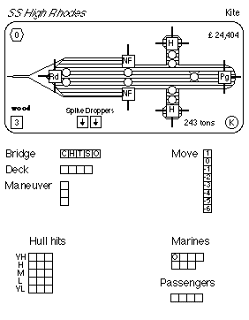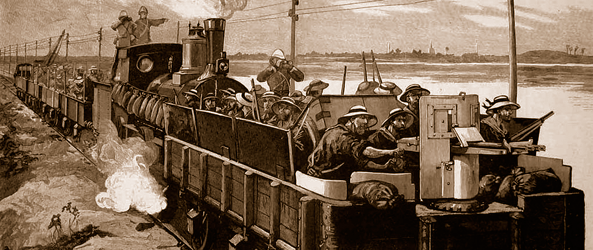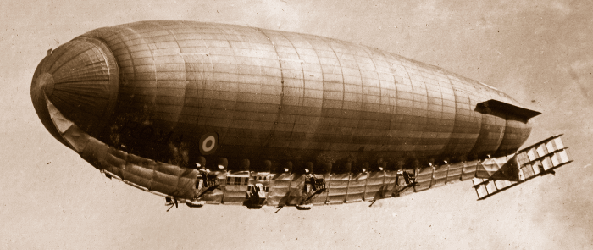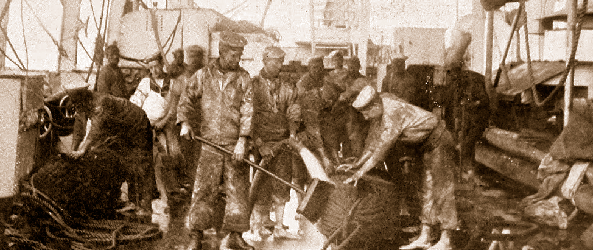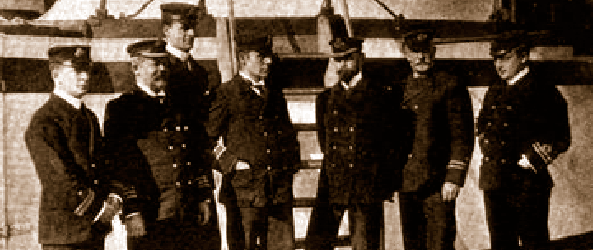COLONEL HOZIER gave a lecture to the officers of the Woolwich garrison at the Royal Artillery Institution, Woolwich, last week, 'upon a subject which may be of very great importance to the Naval and Military services. The subject was the science of communication over considerable distances without the intervention of telegraph wires or cables.
The desire to communicate ideas to a distance has been prevalent probably since history began. In the times of the Napoleonic wars long lines of semaphores were erected between the naval ports and London to keep up communication between the fleets and the Admiralty. Signalling by flags was in vogue long before Nelson flew his famous signal at Trafalgar. Early in this century the commercial code of flag signalling was adopted for the mercantile marine, and more lately a system of signalling, technically known as "flag-wagging," is constantly utilized in all manœuvres. Towards the middle of the century the electric telegraph was developed, and now by means of a conducting wire millions of messages are flashed every day between different continents and under various oceans. In various cases it is impossible or inconvenient to use a conducting wire for this purpose. For instance, if an island be separated from the mainland by a rocky channel where a tide runs strong, it is impossible to maintain a telegraph cable, and in other cases the cost of laying a cable could not be compensated for by the amount of traffic which would be secured, and this would prevent the postal authorities establishing telegraphic communication, especially in this country, where a careful Treasury watches so jealously over the public purse-strings. In such cases it must be of great importance to establish, if possible, communication of ideas between two distant points without the cost of laying a cable. This is still more the case with regard to communication between the shore and ships. A ship, which is moving, cannot possibly be connected by cable with the mainland, hence the only means by which communication of this sort beyond the range of vision can be maintained between a ship and the shore must be by some mode of wireless telegraphy or ætheric signalling. Nor is this the only advantage of ætheric signalling if it can be carried out. Experience has shown us that by means of ætheric signalling work can be done at a distance without any conducting medium for the transmission of energy. For instance, by means of ætheric signalling, it is possible, at a distance, without any actual contact, to fire mines, to ring bells, or to light an incandescent lamp.
It is hardly necessary to point out that if we have the power of doing work at a distance, say, of 20 or 30 miles, by means of ætheric signalling, this system must be of advantage in war. If an enemy were advancing to attack a position, it might be possible to blow up a bridge even when his troops are upon it, and thus considerably hamper his advance. In the same way it might be possible to much inconvenience the enemy by blowing up buildings in which his troops were billeted. It is possible that if his divisions arrived after dark in a village, there would not be very much care taken to search the church towers and see that there was no small piece of wire running down one of them. Yet the existence of that wire, properly arranged by the defending army before it marched out of the village, might cause considerable injury to the invader. Nor need we limit our benevolent intentions towards our enemy to land. At present torpedoes and submarine mines are fired by electricity, by means of conducting wires, but in some cases it might be difficult, if not impossible, to lay the necessary cables. In these cases it is possible that the mines might be exploded and the torpedoes fired by ætheric signalling. For instance, although a cable could not be laid, it might be possible by placing the necessary apparatus on a buoy anchored out at sea beforehand, to secure the firing of a mine or torpedo, as I shall endeavor to show by a miniature experiment.
Ætheric signalling also might be useful in communicating between advance posts at a considerable distance and the main body of an army, or between the main body and the advanced posts. By touching a button in the headquarter office a bell might be rung at the advanced posts, or the same energy which could be utilized to ring a bell might by proper manipulation be also utilized for printing a message, as we shall be able to show at the conclusion of the lecture, and indeed, in some cases, a gun might be placed in position, and when an enemy approached shrouded by rifle fire, it might be possible to fire the gun by ætheric signalling without exposing the gunners to infantry bullets.
 |
| ætheric signal engineers |
Ætheric signalling and wireless telegraphy are much confounded in popular descriptions, but there is a considerable difference between them. There are two systems of wireless telegraphy, which have proved successful. The first of these is that which has been introduced by that great electrical authority, Sir William Preece. Sir William Preece, whose name is received with respect in every scientific meeting in the world, on account of original research which has made him famous, was for many years the head of the telegraph department of the Post Office, and now is the consulting electrical engineer to the Post Office. Hence, he is the greatest living authority on telegraphy. He has devised a system of wireless telephony. The principle of this system is, that suppose it were desired to effect communication without the medium of a conducting wire between the island the mainland, it would be achieved by stretching along the island and along the mainland two parallel telegraph wires, the ends of which would be sunk either in the sea or in the earth. It has been proved by Sir William Preece that if an electrical current be set up in one of these wires, a corresponding current is induced in the other wire, and that hence the signals transmitted through the first wire are repeated in the second wire. In this case it seems that the electrical effects are transmitted not only by induction between the two wires, but by conduction through the earth in which the terminal plates of the wires are embedded. This system has been established at the island of Flatholm, in the Bristol Channel, where Lloyds' signal station is now connected by wireless telephony with the mainland, over a distance of three miles by sea. Sir William Preece has also established his system at the Skerries Islands off the coast of Anglesea, where communication is effected over two miles of sea, and the Post Office is now establishing this system on behalf of Lloyds' to connect Lloyds' signal station at Rathlin Island, on the north coast of Ireland, with the mainland, over a distance of about seven miles. The experiments which have been made, as Sir William Preece states prove conclusively that communication, both telegraphic and telephonic, has been readily maintained by these means, and that wireless telegraphy across the sea by this method is now a practical and commercial system. He also believes that it would be simple to speak by telephone between ship and shore or between shore and ship at a considerable distance by means of a circuit formed of copper wire passing over the topmasts and terminating at each end of the ship in the sea, using simply telephones.
Another system of wireless telegraphy was proposed by Charles A. Stevenson, brother of the engineer to the Northern Lighthouse Board of Scotland. This system, which has been subsequently developed by Professor Oliver Lodge and other engineers, owes its origin, like that of Sir William Preece, to a physical fact discovered by the celebrated philosopher Faraday. Faraday showed that the approach or recession of a current might induce a current in a closed circuit near it. This I will endeavor to show by the apparatus before me, which is a miniature of Mr. Stevenson's coil system. For the purpose of experiment a coil of insulated wire is connected to a battery of two or three cells, with a key to turn the current on or off. A second coil entirely unconnected with the first is joined by wires to a galvanometer. We know that a coil of wire in which a current is circulating acts like a magnet. We find that if, while the current is flowing in one coil, the coil is suddenly moved up towards the other, a momentary current will be induced in the second coil. If the first coil is suddenly moved away from the second another momentary current will be observed in the second circuit. In a similar way if a circuit be made or broken, it has the same effect as suddenly moving the coils. It is evident that if sufficient force can be exerted in the coil by these means to move a galvanometer, the same force can be utilized to move a telegraph needle or any desired means of communication, This system has, I believe, been used, the coils, of course, being much larger and the batteries much stronger, by Mr. Stevenson, in Scotland, and has been fairly successful, but when it was proposed to utilize this system in connecting a lighthouse on an island lying to the north of the Shetland Isles, it was considered that it would have been necessary to place on the lighthouse rock a coil of 40 ft. in diameter and on the shore of the mainland a coil of 200 ft. in diameter. The rock coil would have required about 120 ft. of wire, and the mainland coil about 630 ft. of wire.
The objections to wireless telegraphy appear to be that the length of wire required to transmit messages across a channel is large, and hence inconvenient, and not capable of being adopted where communication must be made from a small space, such as a rock lighthouse. The lecturer prefers to trust to the system of ætheric signalling so called, because the means by which the signals are transmitted depend upon the undulation of the waves of that ether, which we know, exists everywhere throughout the universe, and which is undoubtedly the means of propagation of light and radiant heat. The application of radiant heat to the transmission of signals is more interesting as a scientific experiment than capable of practical use. For practical, useful signalling, we must probably rely on ætheric signalling properly so called.
 |
| clockwork ætheric signalling devices |
It is well known that if the positive and negative poles of a voltaic cell or a voltaic battery be connected by a conducting wire, an electric current flows from the positive to the negative pole. If the battery is strong enough, that current may be made to work–that is to say, it may move a motor, it may ring bells, light incandescent lamps, or be turned into any form of energy required. If the conducting wire be cut and the circuit thus opened, the electrical current immediately ceases to flow and the work that was being done instantly stops. It is perfectly easy for any person standing by a battery to connect by a conductor the two poles and cause the current to flow. The problem to be solved for ætheric signalling is how at a distance of some 10 or 20 or more miles to close the electric current of a battery at will and to open it at will so as to cause work or stoppage of work. This is done in all systems of ætheric signalling which employ the Hertzian waves by means of "a resonator" or what is called a "coherer." Resonators are better adapted for scientific investigations by savants in laboratories than for rough and practical work in the field.
The system of coherers was originally formulated by Branley, Professor of Physics at the Institute of Paris, in 1890, who first discovered that electrical sparks caused undulations in the luminiferous ether, which acted upon a coherer. Since that time the system originally formulated by Branley has been improved upon and amended by Popoff, Bose, D'Arco, Oliver Lodge, Maskelyne and other electricians. It remained for Marconi to draw public attention to the possible commercial value of this system, but there seems nothing in Marconi's patents, which is new except the patent of a special form of coherer, which he employs. A coherer consists essentially of metallic springs or metallic filings. Experience has taught us that when the waves in ether–the Hertzian waves as they are termed–propagated by electric sparks, properly manipulated, even from a considerable distance, impinge on these metallic springs or metallic filings, they cause the springs or filings to cohere, and thus form a conductor for the passage of the electric current. The best coherer as yet brought to public notice appears to be the coherer invented and patented by Mr. Maskelyne. A simple experiment shows that if a coherer be placed in the circuit of a voltaic battery, it does not matter at how great a distance off the Hertzian waves impinge upon it, the electrical current immediately flows and is available to do work such as ringing a bell.
It cannot be too carefully borne in mind that the Hertzian waves do not ring the bell, nor does the coherer do any work. The work done is by the electric current of the local battery at the distant station conducted through the coherer. All that the coherer does is to close the circuit of the local battery. All that the Hertzian waves do is to cohere the coherer, and thus to cause the electric current at the distant station to flow and to do work. It is evident that so long as the Hertzian waves impinge upon the coherer the coherer will be cohered, and the electric current will pass. The next point, therefore, that is necessary to establish, is how to stop the circuit when we do not want the current to pass, or when we want work to be suspended.
Experience has shown that if a coherer is sharply tapped or shaken, the metallic particles fall asunder. There is after shaking, no longer a conduction of electricity through the coherer the electric current of the local battery consequently ceases, and work stops. One of the problems, therefore, of ætheric signalling is to devise a means by which the coherer can be decohered automatically after the receipt of an impulse. This is done by various methods in various systems; Marconi employs a tapper, Ducretet also employs a tapper, and most other systems do the same. In the receiver invented by Mr. Maskelyne, the coherer is not decohered by a tapper but by an armature.
To carry out this decoberence various subsidiary arrangements have to be introduced at the receiving station in the coherer circuit. It is hardly necessary to complicate a simple discussion of broad principles by details of subsidiary machinery, which at the best must be somewhat involved. Much of the success of Mr. Maskelyne's invention depends upon the perfection of the certainty and simplicity of the decohering device. The Maskelyne coherer is so simple that ordinary signalmen can use it and send messages and signals by it. Its action, too, is so certain that for many months the same coherer can be used without the necessity of alteration or regulation. At present it is necessary to have a tolerably high mast in order to secure communication, but it is believed that before long it will be possible to considerably reduce the height of the mast. It is also believed that before long by means of metallic telescopes it will be possible to direct the Hertzian waves, so that they will only impinge upon the particular target to which it may be desired to direct them, and there can be no doubt that experiments will suggest various improvements which will allow for the betterment of the system.
A system of ætheric signalling, which has been tried between Sheerness and Shoeburyness, across the mouth of the Thames, with the Maskelyne coherer, is found to answer very satisfactorily across that distance, which is over five miles. It is probable that great improvements will shortly be made in this system, but in the meantime it is quite sufficiently developed for all practical purposes up to probably 30 miles, and it is not often that, so far as a ship signalling is concerned, a distance of more than 12 miles is required. In some instances the distance across channels over which communication is to be established between islands and the mainland is not nearly so much as 12 miles.
It is apparently established that if a coherer be placed in the circuit of a local battery and by any means that coherer can be made to cohere at will from a distance, so as to allow the electrical current to flow, and can be similarly decohered from a distance, so as to stop the electrical current flowing through the local battery, that local battery will practically do any work that is required. The next question is as to the means by which the coherer can be cohered. This is effected by means of what is called the "Hozier transmitter," which emits sparks across the spark gap between two points. It is well known that if a coil of wire be wound round a piece of iron and a finer coil of wire wound a again around the first coil, an induced current of electricity from the battery with which the coil is connected is sent through the secondary coil at a very high tension. This fact is made use of and the current from these batteries passed through this coil comes out of secondary coil at a high tension and emits sparks across the spark gap. These sparks have the property of causing undulations in the ether, and these undulations are waves which are very similar to the waves of light or of radiant heat. These Hertzian waves, propagated by the oscillating spark across the spark gap, can, like the waves of light when they strike upon a plane surface, be either absorbed, or reflected, or transmitted. If a piece of ebonite, which is an insulator, be placed between the waves and the coherer, the waves will pass through the insulator. If, on the other band, a conductor, such as a piece of copper, be placed in the way, the waves are stopped, and you will see that the coherer has no effect. Ordinary ironwork will act in the same manner. If anybody would wish to study these Hertzian waves (and they form an interesting subject of study) they should refer to the work of Professor Hertz, translated into English for those who do not read German by Professor Jones, with a very valuable preface by Lord Kelvin.
PRACTICAL UTILITY OF ÆTHERIC SIGNALLING
It is not unnatural that those who advocate ætheric signalling may be asked to what extent ætheric signalling will be of practical value. It seems that some damage has been done to ætheric signalling by the exaggerated claims that have been made for its utility. It appears that where it is impossible to make use of a conducting wire, such as a land wire or electric cable, this system of ætheric signalling may be of immense use; for instance, in bridging over those channels where a cable cannot be laid, in communicating between ships and shore, or between shore and ships, where it is impossible that a ship can be connected by cable, and in war where time will not allow a cable to be laid, or when circumstances intervene, such as the presence of an enemy, which prevent cable connection. But it seems that ætheric signalling at present can only be of great practical use where conductors of electricity cannot be utilized. Of course, we do not know what developments science may produce, but at present it is difficult to perceive how this system can be superior to the system of conductive telegraphy. The subject, however, is one of great interest, and no doubt capable of great developments; and it is one well worth the study of those who have an inclination to scientific research.
It is evident that for the purposes of Lloyds, and for the purposes of the mercantile marine, any system by which vessels that require assistance, or aid from the shore, may be able to communicate with the shore is most advantageous. It is evident that a vessel, being a moving body, cannot be connected by telegraph cable with the shore. Therefore, when she is beyond the range of vision so that flag signalling cannot be utilized, it is much to be desired that some system of communication between ship and shore should be established. Flag signalling is always precarious. Manifestly, it cannot be utilized at night. In thick weather, in snow, and sometimes in rain, the signals are obscured and cannot be distinguished. For this reason Col. Hozier and those who have worked with him have done their best to develop some practical system of ætheric signalling which may be the means of every year saving from the perils of the seas thousands of pounds' worth of property and hundreds of human lives
About the Author
Sir Henry Montague Hozier (1838-1907), was a British army officer and pioneer in military intelligence. Like his son-in-law, Winston S. Churchill, Hozier was also a military correspondent: he covered the Austrian-Prussian War for The Times and wrote the official history of the 1867-68 Abyssinian Expedition. Hozier left the army to become the Secretary of Lloyd's of London, in 1874 (a position he held until 1906). One of his most significant innovations was setting up wireless stations to monitor sea traffic, a system which in 1911 put Lloyd's in touch with First Lord of the Admiralty Winston Churchill. Shipping information from Lloyd's network was routinely passed to the Admiralty, where it played a vital intelligence role during the First World War.
This article originally appeared in the March 1901 issue of the Journal of the Military Service Institution (vol. XXVIII, No. 110 pp. 256-264) as a reprint from the Army and Navy Gazette.
